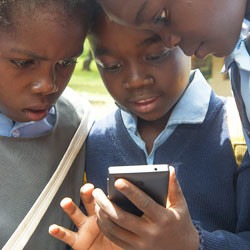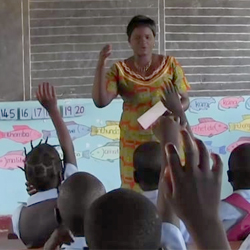Over the last nine months, rural Zambian parents performed magic—turning the phones in their pockets into engaging tales for the youngest members of their households.
As part of the Makhalidwe Athu proof of concept project, crowdsourced local language stories were dispatched in three weekly segments to Zambian families in areas where local language books are hard to come by. The goal: Develop a culture of reading in 1,100 households across rural Eastern Province and explore how basic tech can help to bridge the book gap and boost early grade literacy.
The project was implemented by Creative Associates International. It was funded through All Children Reading: A Grand Challenge for Development, a partnership of the U.S. Agency for International Development, World Vision, and the Australian Government.
In addition to the story dispatches, the project followed each tale with comprehension questions for parents to discuss with their children, sent via SMS. Interactive voice response technology and pre-recorded versions of the story also made it possible for illiterate parents to join in.
Notebooks where young readers transcribed the weekly stories ensured the lessons lived beyond the phone screen. Local radio station and project partner BreezeFM took it upon itself to launch a weekly radio hour when listeners could call in to discuss the tales and literacy in general.
All these pieces led to promising results: an independent impact study revealed that gains in oral reading fluency jumped by the equivalent of one year of schooling for these young readers. Household participation was also high with 100 percent of parents and caregivers reading the stories with their children at least once a week and 98 percent discussing the comprehension questions.
Ayan Kishore, Director of Creative’s Development Lab, reflected on the project’s successes and what it could mean for the future of literacy and technology in other low-resource environments.

What surprised you most about the community response to the project?
Kishore: The project had very high uptake. Almost every parent said that they spend at least once a week with their kids’ reading the story they receive on their phones. In fact, community mobilizers witnessed increased participation by parents over time, and 88 percent of parents reported that the project was helpful to their children’s reading.
The fact that they would sustain that high of an uptake beyond the first few months throughout that project period is very impressive.
As someone designing programs using technology for development there is always a worry that something could be just a fad and that the interest would taper down but it did not. While receiving the SMS messages itself served as reminder to parents to give the stories to their child and spend time with them reading, part of the high participation was also due to the fact that we had mobilizers and volunteers from the community regularly check in with parents and answer their queries.
How did community members respond to the call for crowdsourced stories?
Kishore: The goal of the project was to help push the culture of reading, to bring reading materials into these homes, but also to get people to contribute content that would be very locally relevant to create these stories.
That was an exciting part of the project. People showed really high interest in submitting stories.
A notable role was played by the local radio station Breeze FM. The radio station used public service announcements to spread awareness and to get the community excited in submitting content via SMS or interactive voice response. Inspired by listener interest, it started to broadcast a weekly radio program focused on reading. But the amount of physical submissions of stories to the radio station and schools were even higher [than SMS submissions]. People actually wrote stories on paper and dropped them off at the radio station or at schools.
They were then professionally adapted to grade level and the 160 character SMS format per story segment by project and Ministry of Education specialists, including teachers.
Something I’d like to explore in the future is the whole model of content production for our reading programs. How can crowdsourcing play a bigger role?
Could this model work in other places?
Kishore: I don’t think this model is specific to Zambia or the region. The problems that we faced in Zambia are common: lack of local language reading materials in homes and parents wanting to engage with their kids but not knowing how to do it. I think it is applicable in other places.
The main challenge is figuring out how we can innovatively subsidize these models or get these models such that that they are part of a national approach to mobilize around reading.

Can something as common as SMS, which we use every day, really address something as complex as low literacy and a lack of a culture of reading?
Kishore: There’s always a challenge in technology, particularly technology for development, when people get attracted by the trends in technology and really focus on capitalizing on those trends for funding’s sake. This happens a lot.
But at Creative, our approach is to build on tested methods and trying to meet people where they are. As a technology for development group, that is extremely important for us. We design for the user. They don’t care what fancy technology is behind the service, for them it has got to be as simple as possible to maximize adoption. For them, it’s just getting a message with a new story to read on their phone, that they carry around and use regularly.
Technology cannot work in a vacuum. The way we see technology is not that it is going to itself solve the world’s problems, but as a mechanism to make development more efficient or scalable and to get people engaged in new ways. Here, we capitalized on the fact that kids are attracted to phones to bring reading materials to them and get parents involved and the community excited around reading.
Those were things we wanted to focus on and less so on a new technology.
What do you hope is the legacy of this project, for the development community as well as the families and kids involved in it?
Kishore: This program has already proved to have really high uptake and improve children’s reading skills by providing a means for kids to engage in reading outside of school and for parents and the community to be engaged around reading. Those are things that are evident.
What we would hope is that future programs consider the ways this was designed and the role tech might have played in bringing these things together for future work. Using existing devices that parents own, technology can play a role in education outside the classroom.
As for the kids, they do have these stories and apart from reading, the actual content of the stories can change lives.
One of the first stories that went out in the program was about a second grade girl who really didn’t like to go to school. A teacher had a chat with her one day and made her realize the value of education. After that, she did go to school and ended up being an extremely important person in Zambia. Every time we went to a school and asked the kids their favorite story, all of them said it was that one. There are things that we cannot measure about the power of stories.



